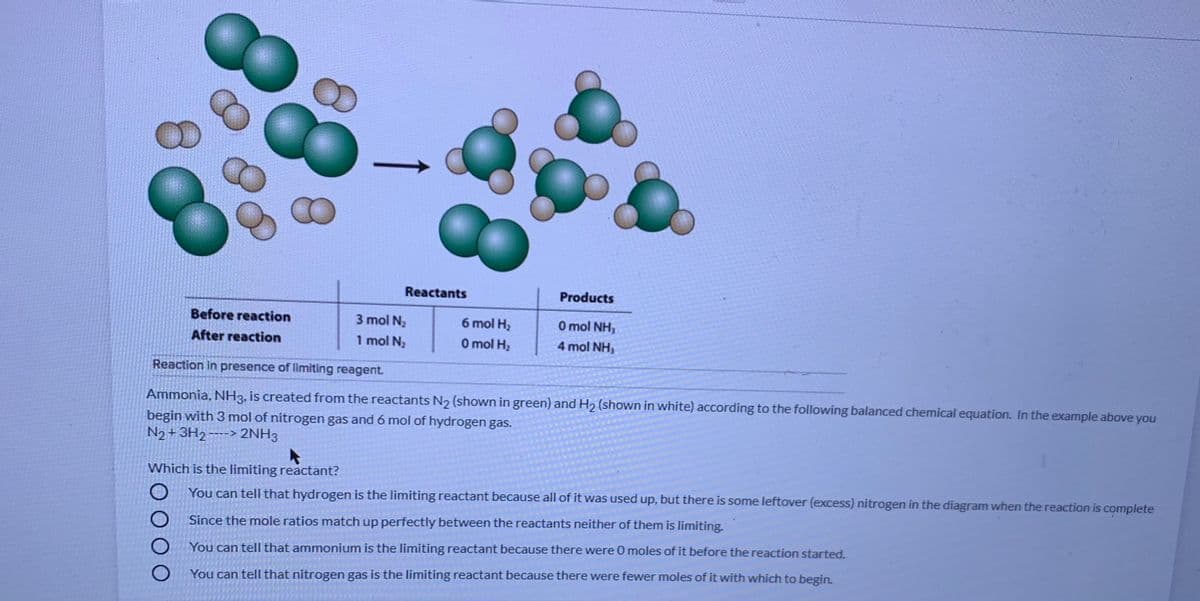Reactants Products Before reaction 3 mol N, 6 mol H, O mol NH, After reaction 1 mol N, O mol H, 4 mol NH, Reaction in presence of limiting reagent. Ammonia, NH3. is created from the reactants N2 (shown in green) and H2 (shown in white) according to the following balanced chemical equation. In the example above you begin with 3 mol of nitrogen gas and 6 mol of hydrogen gas. N2+3H2---> 2NH3 Which is the limiting reactant? You can tell that hydrogen is the limiting reactant because all of it was used up, but there is some leftover (excess) nitrogen in the diagram when the reaction is complete Since the mole ratios match up perfectly between the reactants neither of them is limiting. You can tell that ammonium is the limiting reactant because there were 0 moles of it before the reaction started. You can tell that nitrogen gas is the limiting reactant because there were fewer moles of it with which to begin. 0 0 00
Reactants Products Before reaction 3 mol N, 6 mol H, O mol NH, After reaction 1 mol N, O mol H, 4 mol NH, Reaction in presence of limiting reagent. Ammonia, NH3. is created from the reactants N2 (shown in green) and H2 (shown in white) according to the following balanced chemical equation. In the example above you begin with 3 mol of nitrogen gas and 6 mol of hydrogen gas. N2+3H2---> 2NH3 Which is the limiting reactant? You can tell that hydrogen is the limiting reactant because all of it was used up, but there is some leftover (excess) nitrogen in the diagram when the reaction is complete Since the mole ratios match up perfectly between the reactants neither of them is limiting. You can tell that ammonium is the limiting reactant because there were 0 moles of it before the reaction started. You can tell that nitrogen gas is the limiting reactant because there were fewer moles of it with which to begin. 0 0 00
Introductory Chemistry: A Foundation
9th Edition
ISBN:9781337399425
Author:Steven S. Zumdahl, Donald J. DeCoste
Publisher:Steven S. Zumdahl, Donald J. DeCoste
Chapter9: Chemical Quantities
Section: Chapter Questions
Problem 43QAP: Consider the equation: 2A+B5C. If 10.0 g of A reacts with 5.00 g of B. how is the limiting reactant...
Related questions
Question

Transcribed Image Text:Reactants
Products
Before reaction
3 mol N,
6 mol H,
O mol NH,
After reaction
1 mol N2
O mol H2
4 mol NH,
Reaction in presence of limiting reagent.
Ammonia, NH3, is created from the reactants N2 (shown in green) and H2 (shown in white) according to the following balanced chemical equation. In the example above you
begin with 3 mol of nitrogen gas and 6 mol of hydrogen gas.
N2+3H2----> 2NH3
Which is the limiting reactant?
You can tell that hydrogen is the limiting reactant because all of it was used up, but there is some leftover (excess) nitrogen in the diagram when the reaction is complete
Since the mole ratios match up perfectly between the reactants neither of them is limiting.
You can tell that ammonium is the limiting reactant because there were 0 moles of it before the reaction started.
You can tell that nitrogen gas is the limiting reactant because there were fewer moles of it with which to begin.
Expert Solution
This question has been solved!
Explore an expertly crafted, step-by-step solution for a thorough understanding of key concepts.
Step by step
Solved in 2 steps with 2 images

Knowledge Booster
Learn more about
Need a deep-dive on the concept behind this application? Look no further. Learn more about this topic, chemistry and related others by exploring similar questions and additional content below.Recommended textbooks for you

Introductory Chemistry: A Foundation
Chemistry
ISBN:
9781337399425
Author:
Steven S. Zumdahl, Donald J. DeCoste
Publisher:
Cengage Learning


Chemistry: Matter and Change
Chemistry
ISBN:
9780078746376
Author:
Dinah Zike, Laurel Dingrando, Nicholas Hainen, Cheryl Wistrom
Publisher:
Glencoe/McGraw-Hill School Pub Co

Introductory Chemistry: A Foundation
Chemistry
ISBN:
9781337399425
Author:
Steven S. Zumdahl, Donald J. DeCoste
Publisher:
Cengage Learning


Chemistry: Matter and Change
Chemistry
ISBN:
9780078746376
Author:
Dinah Zike, Laurel Dingrando, Nicholas Hainen, Cheryl Wistrom
Publisher:
Glencoe/McGraw-Hill School Pub Co

Introductory Chemistry: An Active Learning Approa…
Chemistry
ISBN:
9781305079250
Author:
Mark S. Cracolice, Ed Peters
Publisher:
Cengage Learning


Chemistry
Chemistry
ISBN:
9781305957404
Author:
Steven S. Zumdahl, Susan A. Zumdahl, Donald J. DeCoste
Publisher:
Cengage Learning